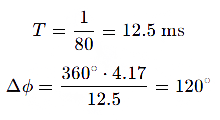System Tuning: How to Optimize Your Professional Audio Setup
Master essential techniques for configuring pro audio systems—phase alignment, EQ, delay management, and limiter use—for optimal clarity and performance.
1. Phase Alignment and Polarity
Why is phase important?
Phase in a sound system refers to the temporal relationship between audio signals from different speakers. Incorrect alignment can cause unwanted cancellations or reinforcements at certain frequencies.
To determine if two signals are in phase, we use the phase difference equation:
Where:
- Δϕ is the phase shift in degrees.
- Δt is the time difference between signals in seconds.
- T is the period of the frequency in seconds.
If Δϕ=180∘, the signals are completely out of phase, which can cause cancellations.
Suppose we have a Tecnare CLA312 system with Tecnare SW218V subwoofers, and a cancellation is detected at 80 Hz. A phase shift of 4.17 ms is measured between the subwoofers and the tops.
We calculate the phase difference for 80 Hz:
This phase shift can be corrected by applying a delay to the subwoofers or inverting their polarity.
Phase correction with delays
If a speaker is out of phase relative to another, a delay can be applied to correct it:
Where:
- t is the delay time in seconds.
- d is the distance difference in meters.
- v is the speed of sound (approximately 343 m/s at 20°C).
2. Equalization and Frequency Response Correction
How does equalization work?
Equalization allows adjusting the level of different frequencies to correct system or environmental deficiencies.
The gain applied to each frequency band is expressed in dB, calculated as:
3. Delay Adjustment and Sound Coverage
Using delays in large systems
In concerts and auditoriums, delay towers are placed to reinforce sound in areas far from the stage. To synchronize these sources, a delay is applied based on distance:
4. Limiters and System Protection
Importance of using limiters
A limiter protects the speakers from excessive signal peaks.
Conclusion
Proper tuning of a professional sound system improves intelligibility, coverage, and equipment protection. With tools like delays, equalization, and FFT analysis, any installation can be optimized to deliver clean and balanced sound.





